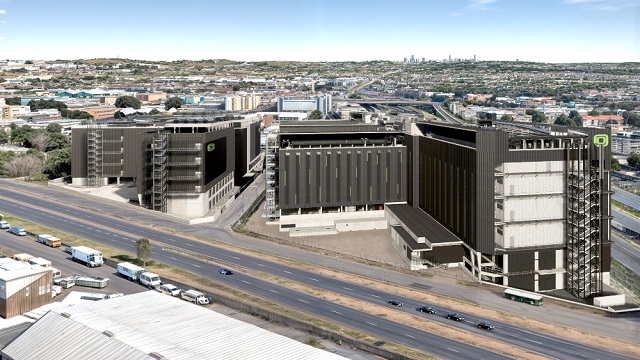Africa’s digital economy is scaling at an unprecedented pace. Teraco and NAPAfrica are building the interconnections that make it possible. From fast and reliable content delivery and access to global cloud on-ramps to co-location facilities, the continent’s largest neutral data centre ecosystem is opening the way for Africa’s next growth phase.

Rendering of JB5 and JB7 on the Isando campus.
NAPAfrica recently surpassed five terabits per second of peak traffic, a milestone that consolidates South Africa’s role as the continent’s primary digital connection point. By keeping African traffic on African soil, the exchange slashes latency, trims transit costs, and unlocks richer user experiences – from streaming to mission-critical enterprise workloads.
NAPAfrica currently has 2 244 physically connected ports and a total connected capacity of 41.5 Tbps. This is in addition to offering direct access to more than 656 unique networks (ASNs) spanning 50 countries, and it is the first African Internet Exchange Point (IXP) to introduce 400 Gbps interconnects. Furthermore, it is 100% neutral; members pay zero port, cross-connect or membership fees – maximising value and advancing regional internet maturity.
An interconnection nexus
With more than 27 500 physical cross-connects, Teraco is Africa’s most interconnected data centre hub and South Africa’s only truly neutral co-location provider. It operates eight data centres across the country, including five in Johannesburg. Teraco recently completed significant expansions at several facilities to enhance its infrastructure and meet growing demand from clients.
In Johannesburg
- The Isando Campus (JB1/JB3/JB5): This hyper-connected campus, with a total critical IT load of 70 MW and 32 000 m² of white space, serves as a central hub for interconnection and co-location services.
- Bredell Campus (JB2/JB4): Located 10 km from Isando, the Bredell facility offers a total critical IT load of 64 MW and 26 300 m² of white space. It provides access to multiple fibre operators between the two campuses, enhancing connectivity options for clients.
In Cape Town
- CT1 (Rondebosch): This facility in the commercial centre of Rondebosch offers 2 500 m² of white space and 3 MW of critical IT load. It serves as a carrier-dense interconnection facility and hosts the NAPAfrica Internet Exchange Point (IXP) in Cape Town.
- CT2 (Brackenfell): Located 35 km from CT1, CT2 is undergoing a 30 MW expansion which will support a total IT load of 50 MW and comprise 16 000 m² of white space. The facility is connected to CT1 via Teraco-owned fibre, facilitating seamless interconnection between the two sites.
In Durban
- DB1 (Riverhorse Valley): Teraco has recently completed an expansion at its Durban facility, doubling its existing capacity to 2 MW. With 1 600 m² of white space, this facility is located on Durban’s north coast, offering secure co-location and interconnection services.
These data centres reflect Teraco’s commitment to supporting digital transformation by providing scalable, secure, and interconnected infrastructure solutions to enterprises and cloud providers across the region. As outlined, the infrastructure extends from the high-density metros of Gauteng to the coastal gateways of the Western Cape and KwaZulu-Natal.
Attracting global content and cloud services providers
By hosting cache servers and cloud on-ramps and content edge nodes inside Teraco – such as Akamai, AWS, Cloudflare, Fortinet, Google, Meta, Microsoft, Mimecast, Netflix Open Connect, Tencent, and more – NAPAfrica delivers:
- Ultra-low latency for streaming, gaming, and SaaS
- Reduced international bandwidth costs for ISPs and enterprises
- Local data sovereignty and compliance advantages
- Compelling value for new peers to join the exchange.
Subsea cable systems such as 2Africa, Equiano, WACS, EASSy, ACE, Seacom, METISS, and SAT-3/SAFE have linked their South African costal landing stations directly to Teraco. This global reach, combined with NAPAfrica’s local fabric, enables networks from Southern, East, and West Africa to access international content without detouring through Europe.
Why it matters
- Economic growth – Faster, cheaper connectivity attracts foreign direct investment from tech giants and stimulates local innovation.
- Digital inclusivity – Free peering lowers barriers for emerging African ISPs, levelling the digital playing field.
- Future-ready bandwidth – 400 Gbps ports and multi-10 Tbps fabric headroom meet tomorrow’s potential AI and Extended Reality (XR) demands.
- Sustainability – Keeping traffic local reduces carbon-intensive international backhaul and supports green energy initiatives at Teraco sites.
Looking ahead
As the adoption of mobile and broadband soars – fuelled by cloud, AI, streaming, and gaming – Teraco and NAPAfrica are doubling down on capacity, reach, and neutrality. They are looking to further expansions of facilities, more regional cache nodes to reduce last-mile distance, and new 400 Gbps participants, anticipating higher peak traffic records.
The world connects to Africa at Teraco, and Africa connects to the world through NAPAfrica. Organisations looking to advance their digital transformation are invited to join the exchange or visit one of the facilities to learn how seamless, scalable interconnection can drive a company’s growth across Africa and beyond.
For more information visit: teraco.co.za